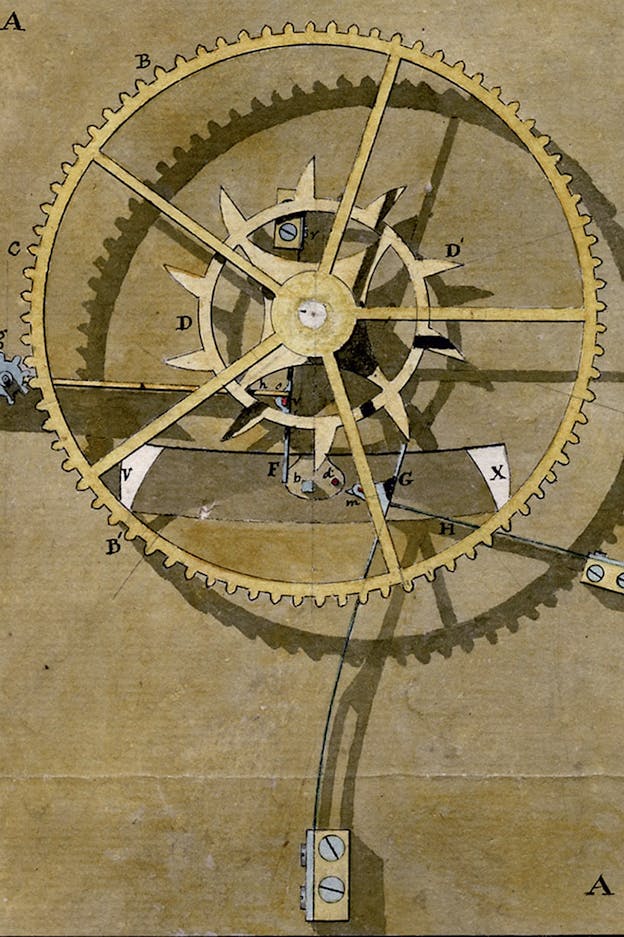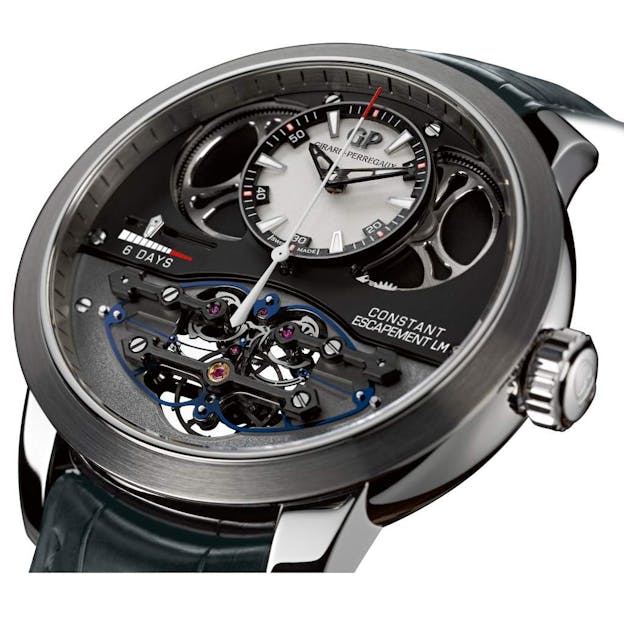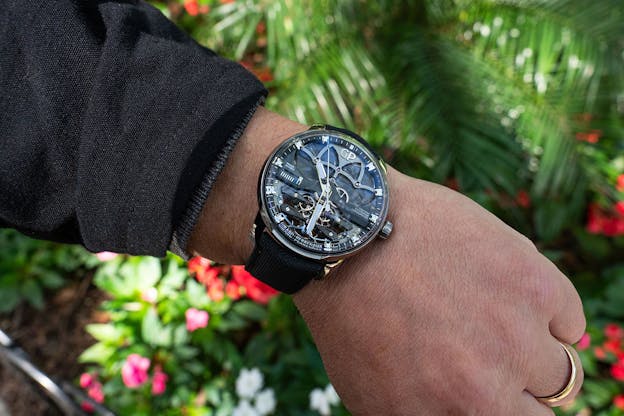The Girard Perregaux Neo Constant Escapement
The quest for constant force has a new benchmark.
Girard Perregaux’s Neo Constant Escapement is the second chapter in Girard-Perregaux’s pursuit of a true constant force escapement. The constant force escapement is, of all the hundreds of different variations on a mechanical escapement, perhaps the most difficult to implement – and while there are constant force mechanisms in many watches, the constant force escapement is one of mechanical horology’s rarest birds.

Constant force escapements – real constant force escapements – are among the rarest mechanisms in the entire history of watch and clockmaking, despite the fact that they should be the ideal solution to one of watchmaking’s toughest problems. Every watch and every clock consists of an oscillator – a balance, or a pendulum – and a mechanism to both count the swings and keep the oscillator oscillating. Ideally an oscillator is isochronous – that is, it takes exactly the same amount of time to complete one oscillation, no matter how big or small that oscillation is. In theory, both the pendulum and the balance ought to be perfectly isochronous but in practice, neither one is and so watch and clockmakers have tried out many different schemes for delivering unvarying energy to the oscillator, on the correct assumption that if the impulse energy never varies, the oscillator will never vary on its rate.
This is the idea behind both the remontoire, and the chain-and-fusée, both of which are, historically, found in watches and clocks whose primary purpose was the best possible precision (John Harrison invented the spring remontoire for his H4 marine chronometer, and fusées are a common feature in marine chronometers in general).

These mechanisms are both designed to smooth out torque variations before energy reaches the escapement, but the constant force escapement does something different. The constant force escapement is designed to give unvarying impulse energy to the escapement directly.
George Daniels’ definition, from Watchmaking, is succinct:
“In the constant force escapement, the impulse to the oscillator is delivered by a separate, small detent, either spring or pivoted with spring. After each impulse to the balance the detent releases the escape wheel which re-sets it on its catch ready for the next impulse. To avoid variation of force due to change of temperature, some form of compensation is needed for the detent. It would nowadays be sufficient to make it of Elinvar [a nickel-steel alloy] which retains constant elasticity with change of temperature.”
Daniels also wrote that, “such escapements do not fulfill their promise … the constant blow of the detent against the impulse pallet, always at the same spot, seems to induce inconstancy of action,” and that, plus their complexity and delicacy, means that they are extremely rare. (I ought to mention that he also praised the constant force escapement in The Art Of Breguet … as F. Scott Fitzerald said, “the test of a first-rate intelligence is the ability to hold two opposed ideas in the mind at the same time, and still retain the ability to function.”)
His note about the complexity delicacy of such escapements seems to be borne out by the fact that almost no one has tried to make them. The only constant force escapements I’m aware of are two made by Thomas Mudge, in the 1770s (the “Blue” and “Green” verge escapement chronometers) some clocks by modern watch and clockmaker David Walter, who seems to have followed Breguet’s design principles, and a handful by Breguet, who patented his constant force escapement in 1798.

Girard-Perregaux’s first version of its constant force escapement was shown at Baselworld in 2013, and for a certain segment of the enthusiast community it was by far the most exciting release not only for that year, but in many years. There have been many more watches with constant force mechanisms in them but constant force escapements are as rare as hen’s teeth, and I honestly thought I would go to my grave without ever seeing one in a modern watch.
The story behind G-P’s CFE is well known but worth repeating (which is true, come to think of it, of most things anyone could write about watches or clocks). Watchmaker Nicolas Dehon, who at the time was working for Rolex, described the evolution of the idea to Monochrome, back in 2013. He got the idea sitting in a train on the way to work, while playing with a paper train ticket.
Imagine you are holding a playing card between two fingers, and you’re pressing just enough to make it bend slightly. If you push against the convex side gently with your free hand, the card will snap backwards so that the convex side is now concave, and you can do this indefinitely. Déhon realized that at the moment the card snaps, it discharges stored elastic energy – the curved shape is basically a bent spring – and that this energy might be used to power an escapement.

Déhon got the idea in the late 1990s and it would eventually go on to become a prototype project at Rolex: Project ELF. (Rolex patented the idea in 1999) The letters are an acronym: E (Échappement) means escapement; L (Lame) in English means blade; and F (Flambage) means buckle (as in, to bend or buckle under pressure; not the buckle on a strap). Rolex got as far as producing some prototype movements but eventually decided – with some justification; a good lever escapement is very hard to beat – that the game was not worth the candle, and Déhon ended up taking the design to Girard-Perregaux. The watch which housed it was the Constant LM, which won the Aiguille D’Or at the GPHG in 2013.

That version of the watch was an imposing 49mm x 14.2mm, with the escapement, balance, and two escape wheels taking up almost half of the available real estate on the dial; it had a 145 hour power reserve (about six days) and of course, what sealed the deal was the fact that over that five day period, the energy going to the balance would remain absolutely constant for every oscillation. Even a one second remontoire on the escape wheel itself generally does not offer such unvarying energy – if you were to graph the energy released from a one second escape wheel remontoire, you’d see a sawtoothed profile, with a tiny spike in energy once per second.

The Neo Constant Escapement works the same way, but there have been, over the last ten years, some refinements to the mechanism as well as to the design.

The escapement itself is significantly more complicated in the details than a lever escapement, but the basic principle is easy to understand. To understand the design changes, let’s first look at the original design – and at the lever escapement, which the Neo Constant escapement replaces.

This is a standard Swiss lever escapement. The escape wheel is rotated clockwise by the gear train. In the image, the escape wheel can’t turn; it’s locked against the the ruby pallet at 1. The balance is rotating counterclockwise and in the image, the balance roller, which is attached to the central axis of the balance, is about to enter the notch in the tip of the lever. As it does, it pushes the lever to the right. This unlocks the escape wheel, which begins to turn and as it does, it pushes against the face of the pallet (1) pushing the lever further to the right, giving impulse to the balance. The lever stops when it hits the banking pin (2, to the right) and the right hand pallet on the lever locks the escape wheel.
Lather, rinse, repeat. The important thing to note is that the lever locks and unlocks the escape wheel, but also transmits the energy from the escape wheel to the balance. These are two distinct steps in the action of the escapement. The escape wheel cannot turn as long as it is locked and the lever only swings far enough to unlock, impulse the balance, and then lock again. The lever escapement is resistant to shock as the pressure of the escape wheel keeps the lever pressed against the banking pin when the escape wheel is locked, and the lever also has the advantage of being self-starting – that is, it’ll start up by itself when you wind the watch, once enough power is wound into the mainspring.
Now, let’s look at the first version of the G-P Constant Escapement, from 2013
Here there are two escape wheels, not one; they are the two wheels with three lobed teeth each, both of which are turned by the gear in between them (the fifth wheel of the going train). The long, S-shaped blade spring is what actually gives impulse to the balance. The impulse spring is armed once per swing of the balance by an impulse lever, which consists of two long curved arms on either side of the balance. The balance as it swings, unlocks the escape wheels and they alternate pressing against the D-shaped pallets of the arming lever as they turn. In doing so, they push the arming lever either to the right or to the left. This pushes the center of the impulse blade spring either left or right, until it snaps into its new position and as it does so, it gives impulse to the balance. The system is, as Daniels said, complex and relatively delicate but it works.
There were however some drawbacks to the original design. One of them was that the escape wheels have to rotate through 120º every time they turn, so when they lock against the D-shaped pallets on the arming lever they do so with more force than if they’d turned through a smaller radius. The locking teeth on the escape wheels are tiny; they’re the minute spurs just visible at the high point of each lobe on the escape wheels. Another problem is that the outer attachment point of the balance spring is immobile, so there’s no way of adjusting for beat error (that is, for making sure that every tick is equal to every tock). Finally, there’s no index for fine adjustment – the balance is freesprung, but the rim screws on the balance look as if they’d be better suited for poising than for timing adjustment.
Now, let’s look at the new design.

Right away you’ll notice that the balance spring now appears to have a mobile stud for adjusting beat error, and there are other changes too. The two escape wheels are the same but if you look closely you’ll see that the tiny spur-like locking teeth in the original version are gone. That’s because the locking function is now taken care of by two small wheels, on the same axis as the escape wheels, which lock and unlock via the light blue, asymmetrical locking arms just under the escape wheels in the image. The locking arms are attached to the outer tips of the arming lever.
I can think of a couple of reasons why the locking arms have been added – first of all, the locking wheels do turn through 120º when the unlock/lock, like the escape wheels, but they move through a smaller distance overall so the impact at locking may be less. Secondly, the new configuration may provide a more secure locking of the escape wheels.

Girard-Perregaux also says that the escapement is now self starting. The press release says, that there are 13 patents associated with this escapement of which 30% are “new,” which I assume means, post-2013. The new patents cover, according to GP, “improvement of the power reserve and efficiency of the escapement,” “improvement of the chronometry and efficiency of the balance wheel” and “complete angular locking of all sequences of the escapement.” G-P also says that the movement is now self-starting.
The action of the escapement is complex but fascinating to watch, and G-P says, ” … all the functions of the escapement—resting, locking, unlocking, and impulse—are now perfectly sequenced and secured. Each phase can only occur if the previous phase is completed, so there can no longer be any ‘mixing’ between different sequences. The functions are perfectly secure without the risk of unlocking or other issues. The escapement also starts perfectly on its own, following a shock or when the power reserve is depleted, thanks to this new arrangement of sequences and the new inclined surfaces on the pallet fork and the escape wheel teeth. The watch behaves as if it has a lever escapement. Once it stops at the end of the power reserve, simply winding it a few turns will restart it.”
These are all major improvements to the original design and while the space taken up by the escapement still means that it is unlikely to replace the more compact, and much simpler, lever escapement any time soon, the changes made go a long way towards making this a practical, albeit still very exotic, escapement. The gain in power reserve is significant as well, going up to a full week from the five days of the previous version. (If you’re curious, there is an excellent synopsis of the evolution of the design through patents filed since 2013 at Watches by SJX).

The escapement is largely composed of silicon components (the s-shaped impulse blade spring is just 14 microns thick, or about one sixth the thickness of a human hair) and the surface oxidation applied to the silicon components catches and reflects the light in either purple or blue, depending on the angle at which light hits the watch.

Overall the design is slightly smaller (the watch is now 45mm x 14.98mm) and the hands have been relocated to the center of the dial, which means better legibility and an overall more balanced design. The overall effect is still, however, more or less the same as in 2013, with a very contemporary color scheme and design cues, including the linear power reserve. However the watch, thanks to the titanium case, is very easy to wear and the action of the escapement is quite interesting to observe.

I thought the Constant Escapement LM was absolutely fascinating in 2013 and it was a very pleasant surprise indeed this year when G-P announced that it was going back into production (although I assume given the fact that pretty much none of the components are off the shelf, means that production numbers are going to be quite low). The watch retains all the intellectual interest of the original but with the bonus of some really interesting changes and updates to the original design, which make the escapement much more practical for daily use. I admire G-P very much for sticking to their guns and working to make the Constant Escapement a more practical one, and the Neo Constant Escapement watch offers a package in terms of design, visual interest, and serious watchmaking content that is quite literally unique.
The only challenge I can see to the acceptance of the watch by high end collectors is the design, which while it does use the characteristic G-P bridges which have been part of its design vocabulary for over a century, the basic design is still a reflection of the era in which the original was conceived and produced. This, however, may not be a disadvantage, inasmuch as while idiosyncratic, the design represents a valid connection to both the original, and to a particular place and time (I could wish, though, that the hands were a little less aggressively sporty; I don’t think they need to try that hard). In any case this watch is scarcely a commercial enterprise; it is, instead, a statement of commitment from Girard-Perregaux, to the pursuit of cutting edge technical watchmaking for its own sake.
The Girard-Perregaux Neo Constant Escapement: Case, titanium, 45mm x 14.80mm, sapphire box crystal and sapphire crystal back; rhodium plated Dauphine hands; water resistance, 30 meters. Movement, Girard-Perregaux GP09200-1153, COSC certified chronometer, 39.50mm x 7.40mm, running at 21,600 vph in 29 jewels. 7 day power reserve. Price, $99,600. Find out more from Girard-Perregaux.

